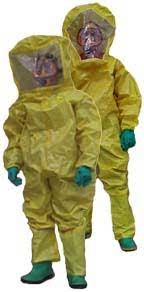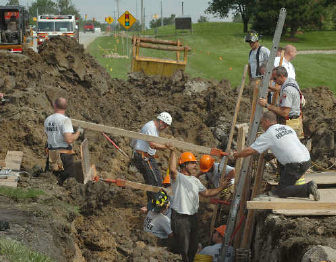Special Operations Division
The Special Operations Division of the Fort Wayne Fire Department consists of three teams: Hazardous Materials Response Team, Water Rescue and Recovery Team, and, Technical Rescue Team.
Training requirements for team members are almost 100 hours per year. These requirements are in addition to the team member's regular training assignments and duties in the Operations Division. To apply for team membership, firefighters must have a minimum of three years on the job, complete a rigorous training schedule, successfully complete an end-of-year evaluation, and, interview for available openings on the team they are seeking to join.
Hazardous Materials Team
The Fort Wayne Fire Department’s Hazardous Materials Response Team covers the City of Fort Wayne as well as Allen County with interagency response and training partnerships with Adams, Allen, Wabash, Miami, DeKalb, Huntington, LaGrange, Noble, Steuben, Wells, and Whitley counties. The team maintains knowledge, skills, and inventory for a Type II response team with some Type I capabilities in accordance with Indiana Hazardous Materials Team Qualification Program for Mobile Support Units. This allows the team to identify and mitigate all unknown industrial chemical hazards. Additionally, they are equipped and trained to mitigate incidents involving various weapons of mass destruction including chemical and biological substances.
Team Equipment
The Fort Wayne Haz-Mat Team has three specialty apparatus it employs. The primary response vehicle, Haz-Mat 1, can make a Level A entry; establish decontamination; monitor hazardous atmospheres with a variety of detection equipment; conduct research via the internet; send and receive fax; and, conduct any number of confinement operations.
Our State Render Safe Trailer is comparably equipped to Haz-Mat 1. This vehicle's primary mission is product identification and decontamination with limited containment equipment.
The Decon Unit consists of a semi-truck and 40-foot box trailer. Its mission is mass decontamination. We can decontaminate up to six people in individual showers and it has the capability of accommodating non-ambulatory patients. In training we have successfully provided decontamination to over 60 patients per hour.
Water Rescue and Recovery Team
The Water Rescue and Recovery Team consists of 30 members. Team members are trained and equipped to respond to incidents involving open water, swift water, and, rapid deployment ice diving. The Team is equipped to dive fully encapsulated into many different water environments.
On duty, team members meet weekly for training regardless of weather conditions. Two training sessions per year are conducted in the pool to evaluate swimming skills, surface rescue techniques and to review a number of contingency exercises. The rest of the year is spent at a variety of locations including several ice- and cold-water dives.
 Divers are trained to the PADI (Professional Association of Diving Instructors) Advanced Open Water Diver Level and then placed on probation for one year. During this time they are introduced to the full-face mask and their training to become a Public Safety Diver begins. At the end of the probationary period, divers are challenged both physically and mentally through a multi-dive evolution at several locations in different water conditions. If the evaluation is successfully passed, probationary divers are placed on the team.
Divers are trained to the PADI (Professional Association of Diving Instructors) Advanced Open Water Diver Level and then placed on probation for one year. During this time they are introduced to the full-face mask and their training to become a Public Safety Diver begins. At the end of the probationary period, divers are challenged both physically and mentally through a multi-dive evolution at several locations in different water conditions. If the evaluation is successfully passed, probationary divers are placed on the team.
Team Equipment
The Water Rescue and Recovery Vehicle and Boat, are kept in service and ready to deploy upon dispatch like all SORT apparatus. Once on scene, divers have the ability to be in the water conducting search operations in less than five minutes. All equipment is serviced and maintained by in-house technicians.
Technical Rescue Team
The Technical Rescue Team has 30 members that are trained and equipped to respond to incidents involving Confined Space; Trench Collapse; High and Low Angle Rescue; Building Collapse; and, Tower Rescue. This team meets the requirements of both OSHA (Occupational, Safety and Health Administration) and NFPA.
Team members meet weekly for training.  Of all the Special Operations Rescue Teams, this is by far the most difficult to master. Some of the training crosses multiple disciplines while others are stand-alone and very technical in nature. Team members must be mechanically inclined, have a good understanding of building construction and heavy equipment and must have the ability to push themselves beyond what is comfortable.
Of all the Special Operations Rescue Teams, this is by far the most difficult to master. Some of the training crosses multiple disciplines while others are stand-alone and very technical in nature. Team members must be mechanically inclined, have a good understanding of building construction and heavy equipment and must have the ability to push themselves beyond what is comfortable.
Team Equipment
The Technical Rescue Equipment consists of a primary response vehicle that carries a variety of shoring equipment; atmospheric monitoring equipment; hard wire communications gear; trench panels; hard- and software for vertical rescue; an assortment of hand and power tools; and much, much more. We also have a one-ton pickup truck and 20-foot trailer that contains most of our building collapse equipment. In addition to the building collapse vehicle, we have a trailer and dump truck dedicated to hauling shoring material for building collapse or trench rescue.
